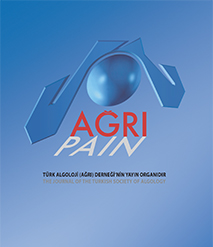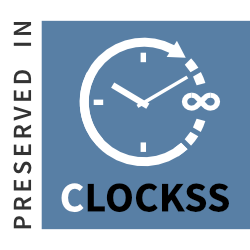Quick Search
Volume: 14 Issue: 1 - 2002
| YAYIN KURALLARI / GUIDELINES FOR PUBLICATION | |
| 1. | Guidelines for Publication Page 4 Abstract |
| YAYIN KURULU / EDITORIAL BOARD | |
| 2. | Editorial Board Page 5 Abstract |
| EDITÖRDEN / EDITORIAL | |
| 3. | Editorial Page 6 Abstract |
| DERLEME / REVIEW | |
| 4. | Discogenic pain M. Hammer Pages 7 - 16 Low back pain is the most common cause of disability. The prevalence of low back is substantial. Discogenic pain is responsible for 40 % of the low back pain cases. Zygapophyseal joint pain is present in 15 %, and sacroiliac joint pain is found in 21 % of low back pain patients. Internal disc disruption (IDD) is the single most common cause of low back pain. Pain on discography provides the anatomical basis for diagnosing back pain. Provocative diagnostic test to determine disc as "pain generator", detects presence of painful annular tears. CT/discography reveals IDD. The diagnosis of IDD relies upon provocation discography that reproduces pain and CT discography that reveals the IDD. A recently released study was the first to correlate MRI and discomanometry in determining lumbar disc disease. Despite increasing knowledge of disc innervation and referred nociceptive pathways, blocking these structures have not demonstrated long term therapeutic effects in uncontrolled clinical trials. |
| 5. | Peripheral and central mechanisms in neuropathic pain A. Yücel Pages 17 - 22 Painful neuropathic conditions may accompany a lesion or dysfunction of peripheral or central nervous system. Painful neuropathies are caracterized by spontaneous or abnormal stimulus evoked pain. Evoked pain is defined as allodynia when caused by normally innoxious stimuli. Hyperalgesia is defined as increased pain intensity evoked by normally painful stimuli. Painful neuropathies are also often associated with nonpainful abnormal spontaneous or and evoked sensory phenomena such as paresthesia and dysestesia. Several animal and human experimental models demonstrate that neuropathic pain is the culmination of a number of changes in the peripheral nervous system. However, many of the drugs that are effective in patients and in animals have effects through central targets. The ultimate goal is to develop satisfactory, and reliable treatment modalities. Help for neuropathic pain patients will require close cooperation among clinicians and scientists. |
| GİRİŞİMSEL YÖNTEMLER / INTERVENTIONAL THERAPIES | |
| 6. | Percutaneous invasive techniques in cervical pain İ. Yegül Pages 23 - 37 Cervical pain is one of the most common problems of the human beings. Most people suffer a period of cervical pain in their lives, which may be due to various etiological reasons. Cervical pain may originate from the facetal joints or the intervertebral discs. This may or may not be caused by degenerative changes. Muscular spasms, sympathetic involvement, neuropathy, and psychosocial factors may cause cervical pain. This review implies the invasive techniques of the cervical pain management. The invasive techniques, should be recognized when conservative therapy is insufficient and applied with right indications by experienced physicians in well equipped centers. |
| 7. | Evidence-based medicine: botulinum toxin A in migraine and tension-type headache H. Göbel, A., Heinze, K. Heinze-kuhn, W. H. Jost Pages 38 - 42 The therapeutic effect of botulinum toxin in headache was observed coincidentally. The rationale for this new indication initially met with a great deal of scepticism, because the toxin’s mechanism of action, cholinergic chemodenervation, does not fit the pathophysiological concept of migraine and other forms of headache. Meanwhile a fair number of studies have been published which indicate efficacy for botulinum toxin and recommend its use for the treatment of tension headache and migraine. According to the evidence-based medicine criteria, grade I evidence has been demonstrated. In addition the use of botulinum toxin for cluster-headache and secondary headache is discussed. Further large scale studies will be regarded to demonstrate the long-term efficacy.. |
| KLİNİK KAVRAM VE YORUM/ CLINICAL CONCEPTS AND COM | |
| 8. | Diagnostic nerve blocks N. S. Özyalçın Pages 43 - 50 Diagnostic blockade is clinically the selective blockade of one modality without blocking others that represent an extremely useful diagnostic tool. Because pain is a totally subjective phenomenon, some objective test is needed to diagnose the neural pathway subserving it as diagnostic neural blockade. However diagnostic neural blockade is not intended to replace a detailed history, a complate physical examination, and appropriate laboratory, and radiologic tests, or psycological assessment. Diagnostic neural blockade has been particularly useful in patients who have intractable pain with no apperent cause. Diagnostic blocks are used to determine the pathophysiology of clinical pain, the site of nociception, and the pathway of afferent neural signals. By the information gained from these blocks, the clinicans decide the choice of medicine, therapeutic blocks as neuroablative therapies, and surgical therapy. Although the clinical success of this modality in many centers, there are many limitations that weaken the theroretic basis for neural blockade as a diagnostic and prognostic tool. The validity of results achieved with diagnosic neural blockade has become conraversial for two main reasons: The changes in understanding factors that determine the process of nerve conduction and blockade are believed by some invalidate the concept of diagnostic/differential neural blockade, and the changes in understanding of the complexity of chronic pain and the physiological, anatomical, and psychosocial factors involved are believed to limit the diagnostic utility of these blocks. For evaluating both the validity and the usefulness of these blocks in the diagnose of pain mechanisms, it is essential to understand the basis of this controversy. |
| KLİNİK KAVRAMLAR VE YORUMLAR / CLINICAL CONCEPTS | |
| 9. | Current status in chronic low back pain A. Ketenci Pages 51 - 54 Low back pain is an important health problem increasing rapidly in industrialised countries. 70 to 85 % of the people suffer from the low back pain in a certain period of their lives. There is no any apparent treatment algorithm for low back pain, such a common social problem. The basic reason of this fact is there are many resources that may lead to pain in lumbar region. Several national and international low back pain treatment guides propose that the patients with low back pain should be treated with multidisciplinary programmes. But, various scientific branches nowadays are a burden for the patients with low back pain, with their different treatment programmes. The surgical interference, as one of the treatment approaches, have been preferred in limited number of patients in the last decade when their results and risks were taken into account. In developing countries where multidisciplinary approaches are less frequently applied and there is no any national programme on the issue, the surgical operation is assumed to be the only solution for low back pain. However, the failed back surgery syndrome, a newly born problem has been the nightmare of the doctors involved in conservative treatments. We hereby present the following case to the readers in order to demonstrate the problems caused by repeated operations and how far the treatment team has been eventually fallen apart from their purposes. |
| DENEYSEL VE KLİNİK ÇALIŞMALAR / EXPERIMENTAL STUD. | |
| 10. | Functional endoscopic sinus surgery under sphenopalatine block or general anaesthesia: effects on postoperative pain O. N. Aydın, S. Başak, F. Ünal Pages 55 - 59 The aim of this study is to compare the postoperative pain scores and analgesic requirements in patients who underwent functional endoscopic sinus surgery after general anesthesia or sphenopalatin ganglion blockade performed by the great palatine (oral) route. The study was approved by the Ethics Committee of Adnan Menderes University Medical Faculty. Sphenopalatine ganglion blockade was applied with lidocaine in Group 1 and bupivacaine in Group 2. General anesthesia was administered in Group 3. Pain was evaluated with Visual Analogue Scale (VAS) preoperatively and 2, 6, 24 hours after the surgery. Analgesic requirements were documented postoperatively for two days. VAS scores were significantly higher in Group 3 at the second hour. The patients’ analgesic requirements were almost two times higher in Group 3 than the regional groups. Regional anesthesia may be preferred to general anesthesia in functional endoscopic sinus surgery operations because patients experience less pain and require less analgesics postoperatively. |
| 11. | Determination of risks and benefits of intrathecal tramadol hydrochloride in rabbits S. Gürsoy, H. Kafalı, N. Kunt, F. Göze Pages 60 - 67 The risks and benefits of intrathecal tramadol hydrochloride application in rabbits has been studied. In this study 35 male, Albino type New Zelland rabbits were used. The rabbits were divided into 5 groups. A, B, C and D groups were administered intrathecally single dose 1, 2, 4 and 8 mg/kg tramadol hydrochloride respectively and also single dose of saline was given intrathecally to the control group. Pain treshold, whether the seizures improved or not, respiratory depression, motor disfunction and sedation grade were evaluated at the intervals of 5, 15, 30, 60 and 120th min. Additionally neurotoxicity was searched histopathologically. It has been detected that tramadol has moderate analgesic potential which starts rapidly, lasts for a short time and depends on the dose. Motor disfunction and seizures were not observed. Light sedation and respiratory depression were observed at high doses. Neurotoxicity was found in all groups except the control group. Intrathecal tramadol hydrochloride has moderate analgesics effects which lasts for a short time and low incidence of side effects. It is assumed that it has toxic effect on the spinal cord. |
| ABSTRACTS | |
| 12. | Abstracts Pages 68 - 71 Abstract |
| KITAP TANITIMI | |
| 13. | Kitap tanıtımı Page 72 Abstract |
| TOPLANTI TAKVIMI | |
| 14. | Toplantı Takvimi Page 73 Abstract |





